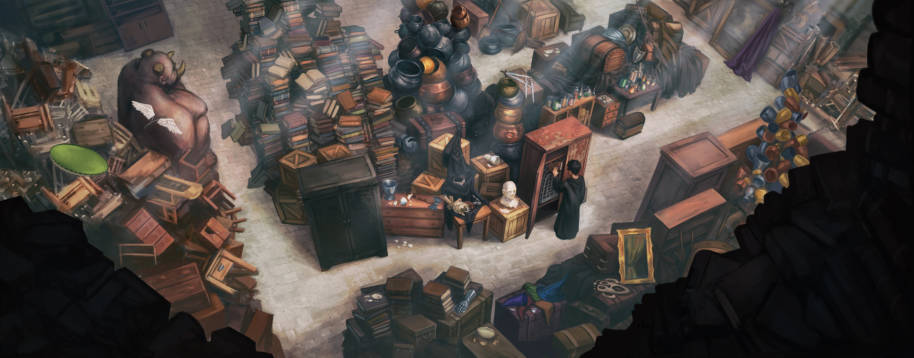
Hogwarts School of Witchcraft and Wizardry is a castle so ancient, so full of magic, that not even Albus Dumbledore knows all of its secrets. There are questions to be asked about Hogwarts, mysteries to be unravelled about its history, its grounds and its soul – mysteries such as...
Who was the wizard architect behind Hogwarts?
It’s well-known that Hogwarts was founded by two wizards and two witches: Godric Gryffindor, Salazar Slytherin, Helga Hufflepuff and Rowena Ravenclaw. But who planned and designed the actual castle? The books don't speak of an architect as such but the films are a bit more helpful, treating us to the sight of a golden statue known as the Architect of Hogwarts: a bearded wizard holding a scroll (presumably the Hogwarts blueprints) and a miniature model of the castle. Who this man is, exactly, is unknown, but it makes sense that the founders would need a wizard who could put their ideas into action. Castles don’t just build themselves. Or do they?

And why is Hogwarts in Scotland?
Of all the locations in Britain, why was Hogwarts built in the Highlands of Scotland? After all, only one of the four Founders – Rowena Ravenclaw – was Scottish. Why not build it in Helga Hufflepuff’s native Wales? Or the England of Godric Gryffindor and Salazar Slytherin? A good theory is simply that, with all its Highlands and hills, Scotland is a pretty handy place to build a secret fortress: spacious, remote and lovely. Also, J.K. Rowling wrote the books in Scotland, which probably helped matters too.
But all in all, it's just a lovely, picturesque location - not to mention being near a lake and a forest. Sure, both have quite a few terrifying magical creatures dwelling within them, but lovely to look at from the outside!

What are the limits of the Room of Requirement?
When introduced to the concept of a room that can turn into ‘anything’ the wizard or witch requires, we must ask this rather massive question: what counts as ‘anything’?
The Room of Requirement transformed into many different rooms during Harry’s time at Hogwarts, such as the headquarters for Dumbledore’s Army, a place to hide Horcruxes and dodgy Potions books, and even a house-elf recuperation centre for poor Winky to sleep off the Butterbeer.

There are certain things we know the room definitely can’t do. According to the five Principal Exceptions to Gamp’s Law of Elemental Transfiguration, for instance, it cannot produce food. You can bring food into the Room of Requirement, but don’t expect much if you suddenly ‘require’ a banquet. But what else can and can’t the Room do? Can it summon people, if you suddenly fancy talking to the Minister of Magic? How big can it get? Can you truly ‘require’ a room that absolutely no one else can ever enter? If the Room can create a passage to the Hog’s Head, can it make passages to further away places, such as Brazil? Probably not, but you can’t blame us for wondering.
Check out some of the things we wish the Room of Requirement could turn into here.
Why do ghosts return to Hogwarts?
In any tradition, beyond Harry Potter, it’s common knowledge that ghosts usually return to the living world because of ‘unfinished business’. This is also true of certain Hogwarts ghosts. We know that Moaning Myrtle came back to haunt the bully who made her life hell. We know that the Grey Lady has a sad past with her mother, the Hogwarts founder Rowena Ravenclaw.

Nearly Headless Nick is a bit more of a question mark. Although he attended Hogwarts and was sorted into Gryffindor, how he returned to be the official ‘Gryffindor ghost’ is uncertain, but we do know why the undead are so attracted to Hogwarts at least. According to J.K. Rowling, ‘The castle is a congenial place for ghosts, because the living inhabitants treat their dead friends with tolerance and even affection, no matter how many times they have heard the same old reminiscences.’ Well, that’s nice.
Do the students study maths and English?
While Muggle-born students will be familiar with a Muggle primary school curriculum, it is uncertain to what degree these more practical lessons are carried over to Hogwarts-level. In Muggle life, maths, science and English are crucial – but if you’re a witch or wizard with an endless array of spells at your disposal, are you really that bothered about grammar or equations?

We do know that Hogwarts has Arithmancy, available in the third year, which only Hermione chooses to do, naturally. In Greek, this term means ‘divination by numbers’, so although we can gather numbers are certainly something to do with it, we don’t know much beyond that. As for English, although it’s doubtful Hogwarts students study the works of Shakespeare, with no TV or video games around, they probably read their fair share of books.
And what about P.E.?
Physical education is a standard Muggle requirement, but the only exercise we really see witches and wizards do is flying in their first year.

And how much exercise really goes into Quidditch apart from steering a broom? Maybe we are wrong to judge – we’ve never done it, after all. And although no conventional lesson for exercising exists, the Hogwarts students do at least get a lot of unexpected workouts – such as running away from Peeves or three-headed dogs.
How many students have died at Hogwarts?
We’re often told how safe Hogwarts is, but is it, really? With moving staircases, secrets hidden in every crevice, not to mention a dangerous-looking Forbidden Forest, we do wonder. But as far as we know, there isn’t too much evidence suggesting fatalities.

Despite the horrific heights and dangers of Quidditch, Oliver Wood promises Harry no one ever died playing it, just ‘a couple of broken jaws’. It seems that deaths only really occur in extenuating circumstances – which sadly, Hogwarts seems to attract. We know Moaning Myrtle lost her life to the Basilisk, and during the reopening of the Chamber of Secrets, many more students very nearly followed suit. But besides the Battle of Hogwarts, the only student Hogwarts mourned during Harry’s time there was Cedric Diggory, and that was only due to Lord Voldemort’s interference.
Is Hogwarts alive?
It may sound strange, but it’s not unreasonable to question whether Hogwarts – a building infused with hundreds upon hundreds of years of magic – has gained some form of sentience.

To clarify: we’re not talking about staircases that move here, which have merely been enchanted to seem like they’re alive. We’re talking about the castle as a quasi-living entity, with something approaching thoughts and feelings. There are many little examples, of course. The notorious trick steps hint at a castle being mischievous, while the Room of Requirement appears to have some semblance of intelligence. There's also various sentient objects, such as The Quill of Acceptance and The Book of Admittance, that help choose students for Hogwarts. And of course, we also have The Sorting Hat.
The most striking example of the castle being 'alive' however, comes in Harry Potter and the Order of the Phoenix, in which it sealed the Head’s office against new headmistress Dolores Umbridge. But why? Was the castle somehow aware of what was going on? Had it, in a way, grown loyal to Albus Dumbledore? Or was it just trying to protect its students?
Perhaps it's more fun to never know...

